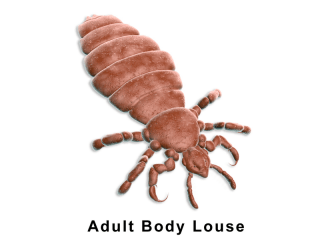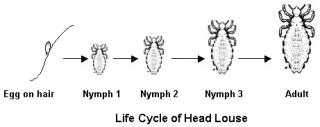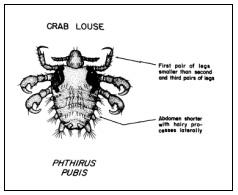What are lice?
Lice are six-legged, wingless, insect parasites of humans, mammals (cattle, pigs etc.), and birds (chicken and other birds). Lice are divided into two groups: lice found on mammals, which need blood for sustenance; and those found on birds, which chew on feathers and dandruff. The three most common external parasites of humans are:
- Head lice (Pediculus humanus capitus)
- Body lice (Pediculus humanus humunas)
- Crab lice (Pthirus pubis)
All lice have flattened bodies to allow them ease of movement in the hair, fur, and feathers of their hosts. Infestation of a person with head and/or body lice is termed "Pediculosis" and with crab lice is called "Pthiriasis."
Pediculousis, or infestation with body and/or head lice, causes little irritation initially. After weeks of continued biting, some individuals may become sensitized and suffer an allergic reaction. Head lice infestation results in intense itching of the scalp behind the ears and base of the hairline or nape of the neck. Sores may form on the head from scratching and may become infected with bacteria. The symptoms of body lice infestation are scratch marks, hives, eczema and a red rash on shoulders and other areas covered with clothes. Pthiriasis, or pubic lice (crab lice) infestation, results in continued itching in the pubic area, a rash, and sometimes discoloration of skin from continued feeding by crab lice.
Head Lice
Head lice are found among hair on the human scalp. Commonly, they can be found on the scalp behind the ears and near the neckline at the base of the scalp. In the United States, head lice are most common among school-aged children. Head lice is more common among girls than boys because they share hats, scarves, hairbrushes, and other hair accessories more frequently.
Head lice are 2mm (male) to 3mm (female) in length. Full-grown adults are approximately the size of a sesame seed. The color of head lice tends to match the hair color of human hosts, ranging from pale tan to dark brown. All lice use the well-developed claws on their legs to grasp hair. Head lice can cling to fine hair on the head. However, they are incapable of clinging to coarser hair on the body and so they are not found on pubic hair. They are slow feeders and cling tightly to head hair while feeding.
Head lice lay oval, yellowish-white, opalescent eggs (nits) on the base of the hair shafts. Eggshells can remain attached to the hair long after the young have hatched. Head hair continuously grows, so any eggs 1 cm above the scalp surface level are mostly hatched or dead. In serious cases, secondary bacterial infections of bite sites may occur.
A common misconception is that lice infestation is a result of poor hygienic practices. In fact, it is actually believed that head lice prefer clean hair to dirty hair. However, their number increases due to a lack of combing and bathing.
Head lice may be spread through shared use of combs and hairbrushes, use of bedding by more than one person, and the sharing of hats and other contaminated accessories. Head lice can survive only for brief periods of time on bedding or upholstered furniture.
What do head lice feed on?
Head lice feed on blood from their human hosts and die in the absence of a human host (ie. they cannot live on pets). They cannot survive more than 48 hours at room temperature (23-24° C) away from their host.


